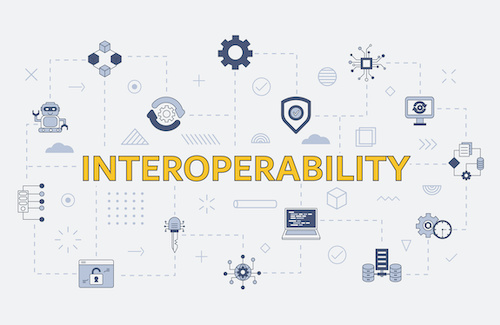This post on interoperability originally appeared on CoSN’s blog and is reposted here with permission.
Key points:
Interoperability is the seamless, secure, and controlled exchange of data between applications. Implementing interoperability can bring information from edtech tools together to holistically contextualize student learning, allowing educators, schools, and districts to understand their students better and support their paths to graduation. Executing data interoperability standards creates a modern data infrastructure by supporting improved development, privacy, and cybersecurity practices while ensuring compliance with industry best practices.
Interoperability has often been seen as an extra step that districts couldn’t necessarily implement due to capacity. However, as privacy and security become increasingly important due to advancing technology, so has the need for interoperable systems.
As Project Director of Project Unicorn, my role has been to show educators and edtech vendors why interoperability is a critical foundational component of a data ecosystem. I often speak with district administrators or edtech vendors who have never heard of “interoperability” or don’t know about using K-12 data standards. This is why Project Unicorn was created; to build a movement for data interoperability and ensure that everyone can access important knowledge about the building and implementation portion of data interoperability.
Project Unicorn works with early adopters who are ready to start their interoperability journey, knowing they have the privacy and security practices to begin. But as new technologies emerge, like generative AI, and as cybersecurity breaches continue to increase (80 percent of school IT professionals reported that their schools were hit by ransomware in 2023, up from 56 percent in 2022, noted in a recent article), educators, solutions providers, and government officials alike have realized that interoperability, privacy, and security enhance each other, and an integrated ecosystem matters.
“The importance of interoperability’s intersection with privacy and security cannot be overstated,” said Paula Maylahn, CoSN, Interoperability Project Director and Principal Consultant at Paula Maylahn Consulting. “Often, the focus on interoperability is on one side of the coin–getting data where it needs to go. Equally as important is the flip side–keeping data from where it should not go.”
How interoperability, privacy, and security enhance each other
Practicing data interoperability can support improved development, privacy, and cybersecurity while ensuring compliance with industry best practices from both districts and vendors in these ways:
Interoperability standards add clarity to data collection and management
Interoperability has the potential to support data portability and ownership
Interoperability standards can improve product usability and security
Supporting interoperability increases transparency around data practices
Interoperability standards can help simplify the process of compliance with privacy laws
(Learn more about Privacy, Security, and Interoperability at https://www.projectunicorn.org/resources/privacy-security-interoperability)
Interoperability at the White House
On Monday, August 7, 2023, a group of school superintendents, educators, and education technology vendors met at The White House with First Lady Jill Biden, Secretary of Education Miguel Cardona, and Secretary of Homeland Security Secretary Alejandro Mayorkas to unveil the new Infrastructure Briefs, a series of three documents by the Office of Educational Technology, one including Cybersecurity and Infrastructure Security Agency (CISA). They spoke on the importance of interoperability and cybersecurity in building safe and resilient data ecosystems in K-12. This “Back to School Safely” event framed how to build an interoperable, secure, and privacy-enabled ecosystem for education technology and support the field.
A national plan for edtech
Following the Infrastructure Briefs, the United States Department of Education released the 2024 National Educational Technology Plan (NETP) on January 22, 2024.
Since 1996, the NETP has served as the flagship educational technology policy document for the United States, setting a vision and plan for K-12 learning enabled by technology across the U.S., territories, tribal lands, and DoDEA schools worldwide. This latest iteration of the NETP delves into the transformative potential of educational technology, highlighting systemic solutions to bridge the digital divides in use, design, and access, particularly in the context of educational equity.
The 2024 NETP aligns with the Activities to Support the Effective Use of Technology (Title IV A) of the Every Student Succeeds Act and continues to promote a vision of equity, active use, and collaborative leadership. It aims to ensure equitable access to technology and the transformative learning experiences that technology enables.
“In the real, day-to-day work of interoperability in a K-12 school district, the goal is to get actionable data in the hands of administrators and educators to make the best possible decisions to ensure all of our students succeed,” said Dr. Chantell Manahan, Director of Technology (MSD of Steuben County & CoSN Board Member) “While we can achieve this through hard work by intentionally designing infrastructure, building local capacity, aligning with vetted data standards, and choosing the EdTech vendors who also champion this vision, it is never easy. And we have an obligation to achieve this interoperability at scale, all while protecting student data privacy. This means ensuring access to student data on a need-to-know basis, following all federal, state, and local laws and community norms. It’s a delicate balancing act of access to the right data for the right decision-makers, and support from the federal level through the infrastructure briefs and the NETP provide the guidance and prioritization of interoperability for achieving this digital equity.”
Don’t fall behind: Steps districts can take
To keep up with emerging technologies and keep your data infrastructure and student data secure, you must ensure the foundational pieces of the data ecosystem are in place: interoperability, privacy, and cybersecurity. With that foundation in place, your technology can advance, benefiting students without worrying about security.
Use the Project Unicorn School System Data Survey tool to assess your data ecosystem. The brief survey is designed to help the education sector better understand current K-12 school system capabilities for leveraging education data. Review your results with free personalized resources and technical support from the Project Unicorn team.


